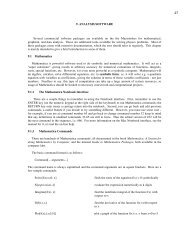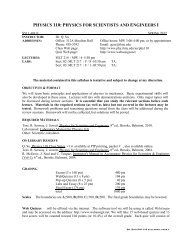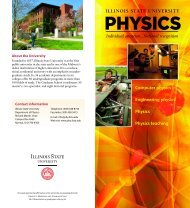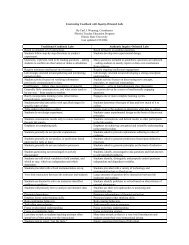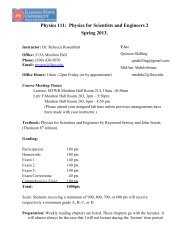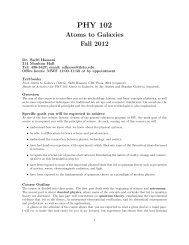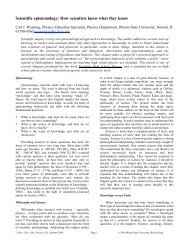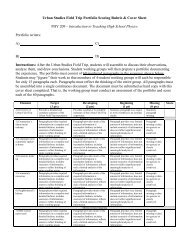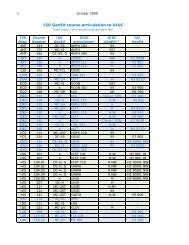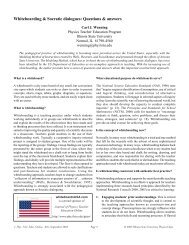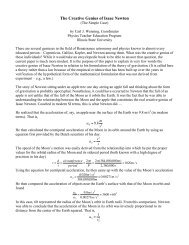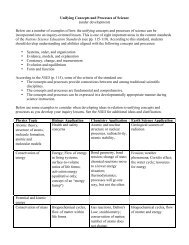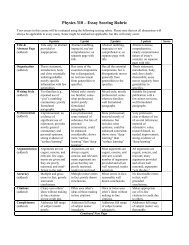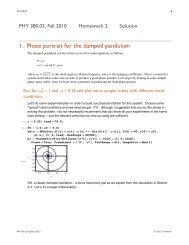Chi-Square Test for Goodness of Fit - Department of Physics
Chi-Square Test for Goodness of Fit - Department of Physics
Chi-Square Test for Goodness of Fit - Department of Physics
Create successful ePaper yourself
Turn your PDF publications into a flip-book with our unique Google optimized e-Paper software.
<strong>Chi</strong>-<strong>Square</strong> <strong>Test</strong> <strong>for</strong> <strong>Goodness</strong> <strong>of</strong> <strong>Fit</strong><br />
Scientists <strong>of</strong>ten use the <strong>Chi</strong>-square (χ 2 ) test to determine the “goodness <strong>of</strong> fit” between<br />
theoretical and experimental data. In this test, we compare observed values with theoretical or<br />
expected values. Observed values are those that the researcher obtains empirically through direct<br />
observation. The theoretical or expected values are developed on the basis <strong>of</strong> an established<br />
theory or a working hypothesis. For example, we might expect that if we flip a coin 200 times,<br />
that we would tally 100 heads and 100 tails. In checking our hypothesis, we might find only 92<br />
heads and 108 tails. Should we reject this coin as being fair? Should we just attribute the<br />
difference between expected and observed frequencies to random fluctuation?<br />
Consider a second example: let’s suppose that we have an unbiased, six-sided die. We<br />
roll this die 300 times and tally the number <strong>of</strong> times each side appears:<br />
Face<br />
Frequency<br />
1 42<br />
2 55<br />
3 38<br />
4 57<br />
5 64<br />
6 44<br />
Ideally, we might expect every side to appear 50 times. What should we conclude from these<br />
results? Is the die biased?<br />
Null Hypothesis<br />
The use <strong>of</strong> the chi-squared distribution is hypothesis testing follows this process: (1) a<br />
null hypothesis H 0 is stated, (2) a test statistic is calculated, the observed value <strong>of</strong> the test statistic<br />
is compared to a critical value, and (3) a decision is made whether or not to reject the null<br />
hypothesis. An attractive feature <strong>of</strong> the chi-squared goodness-<strong>of</strong>-fit test is that it can be applied<br />
to any univariate distribution <strong>for</strong> which you can calculate the cumulative distribution function.<br />
The null hypothesis is a statement that is assumed true. It is rejected only when the data has a<br />
degree <strong>of</strong> statistical confidence that the null hypothesis is false, when the level <strong>of</strong> confidence<br />
exceeds a pre-determined level, usually 95 %, that causes a rejection <strong>of</strong> the null hypothesis. If<br />
experimental observations indicate that the null hypothesis should be rejected, it means either<br />
that the hypothesis is indeed false or the measured data gave an improbable result indicating that<br />
the hypothesis is false, when it is really true. This is an un<strong>for</strong>tunate property <strong>of</strong> statistics.<br />
Calculating <strong>Chi</strong>-squared<br />
For the chi-square goodness-<strong>of</strong>-fit computation, the data are divided into k bins and the<br />
test statistic is defined as<br />
k<br />
2<br />
2 ( Oi<br />
− Ei<br />
)<br />
χ = ∑<br />
(7)<br />
i=<br />
1 Ei<br />
where O i is the observed frequency <strong>for</strong> bin i and E i is the expected frequency <strong>for</strong> bin i. <strong>Chi</strong>squared<br />
is always positive and may range from 0 to ∞.<br />
The chi-squared goodness-<strong>of</strong>-fit test is applied to binned data (i.e., data put into classes)<br />
and is sensitive to the choice <strong>of</strong> bins. This is actually not a restriction, since <strong>for</strong> non-binned data,<br />
a histogram or frequency table can be made be<strong>for</strong>e generating the chi-square test. However, the
values <strong>of</strong> the chi-squared test statistic are dependent on how the data is binned. Another<br />
disadvantage <strong>of</strong> the chi-square test is that it requires a sufficient sample size in order <strong>for</strong> the chisquare<br />
approximation to be valid. There is no optimal choice <strong>for</strong> the bin width (since the optimal<br />
bin width depends on the distribution). Most reasonable choices should produce similar, but not<br />
identical, results. One method that may work is to choose bins that have a width <strong>of</strong> s/3 and lower<br />
and upper bins at the sample mean ±6s, where s is the sample standard deviation. For the chisquare<br />
approximation to be valid, the expected frequency should be at least 5. This test is not<br />
valid <strong>for</strong> small samples, and if some <strong>of</strong> the counts are less than five, you may need to combine<br />
some bins in the tails.<br />
Let’s apply this now to the above examples:<br />
Table I: The Coin Toss Example<br />
Face O E (O − E) 2 / E<br />
Heads 92 100 0.64<br />
Tails 108 100 0.64<br />
Totals 200 200 χ 2 =1.28<br />
Table II: The 6-sided Die Example<br />
Face O E (O − E) 2 / E<br />
1 42 50 1.28<br />
2 55 50 0.50<br />
3 38 50 2.88<br />
4 57 50 0.98<br />
5 64 50 3.92<br />
6 44 50 0.72<br />
Totals 300 300 χ 2 =10.28<br />
Degrees <strong>of</strong> Freedom<br />
We have seen how to calculate a value <strong>for</strong> chi-squared, but so far, it doesn’t have much<br />
meaning. The chi-square distribution is tabulated and available in most texts on statistics (and<br />
reprinted here). To use the table, one must know how many degrees <strong>of</strong> freedom df are associated<br />
with the number <strong>of</strong> categories in the sample data. This is because there is a family <strong>of</strong> chi-square<br />
distributions, each a function <strong>of</strong> the number <strong>of</strong> degrees <strong>of</strong> freedom.<br />
The number <strong>of</strong> degrees <strong>of</strong> freedom is typically equal to k −1. For example, in the die<br />
example, the expected frequencies <strong>for</strong> each <strong>of</strong> the two categories (heads, tails) are not<br />
independent. To obtain the expected frequency <strong>of</strong> tails (100), we need only subtract the expected<br />
frequency <strong>of</strong> heads (100) from the total frequency (200). Similarly, <strong>for</strong> the die example, there<br />
are six possible categories <strong>of</strong> outcomes: the occurrence <strong>of</strong> each <strong>of</strong> the faces. Under the<br />
assumption that the die is fair, we expect a frequency <strong>of</strong> 50 <strong>for</strong> each <strong>of</strong> the faces, but these again<br />
are not independent. Once the frequency count is known <strong>for</strong> five <strong>of</strong> the bins, the frequency <strong>of</strong><br />
the sixth bin is determined, since the total count is 300. Thus, only the frequencies in five <strong>of</strong> the<br />
six bins are free to vary − leading to five degrees <strong>of</strong> freedom <strong>for</strong> this example.
Levels <strong>of</strong> Confidence<br />
A chi-square table, like Table III, lists the chi-squared distribution in terms <strong>of</strong> df and in<br />
terms <strong>of</strong> the level <strong>of</strong> confidence, α = 1 − p. This chi-squared goodness-<strong>of</strong>-fit method is not<br />
without risk; and the data may lead to the rejection when in fact it is true. This is why we speak<br />
<strong>of</strong> confidence. In the coin flip example, the null hypothesis is that the frequency <strong>of</strong> “heads” is<br />
equal to the frequency <strong>of</strong> “tails.” In the more general case, we do not require equal probability<br />
<strong>for</strong> each <strong>of</strong> the categories. There are many cases where an expected category will contain the<br />
majority <strong>of</strong> tally marks over all other categories (one such example would be a survey enquiring<br />
about the public’s choice in an upcoming presidential election that includes all candidates on the<br />
ballot).<br />
In Table III, the critical values <strong>of</strong> χ 2 are given <strong>for</strong> up to 20 degrees <strong>of</strong> freedom. Four<br />
different percentile points in each distribution are given <strong>for</strong> 1 − p = 0.10, 0.05, and 0.025. The<br />
standard practice in the world <strong>of</strong> statistics is to use a 95 % level <strong>of</strong> confidence in the hypothesis<br />
decision making. Thus, if the value <strong>of</strong> chi-squared that is calculated indicates a value <strong>of</strong> p that is<br />
less than or equal to 0.05, then the null hypothesis should be rejected. In the coin-flip example,<br />
you can toss a coin and get 14 heads out <strong>of</strong> twenty flips and find p = 0.0577. This would indicate<br />
that such an observation can happen by chance and the coin can be considered a fair coin. Such<br />
a finding would be described by statisticians as “not statistically significant at the 5 % level.” If<br />
one found 15 heads out <strong>of</strong> 20 tosses, then p would be somewhat less than 0.05 and the coin<br />
would be considered biased. This would be described as “statistically significant at the 5 %<br />
level.” The significance level <strong>of</strong> the test is not determined by the p value. It is pre-determined<br />
by the experimenter. You can choose a 90 % level, a 95 % level, a 99 % level, etc.<br />
For the coin flip example, with one degree <strong>of</strong> freedom. The χ 2 <strong>for</strong> the experiment given<br />
in Table I is only 1.28. This corresponds to a p = 0.26, which is somewhat greater than 0.05.<br />
There<strong>for</strong>e, the null hypothesis that the die is fair cannot be rejected. The smaller the p-value, the<br />
greater is the likelihood that the null hypothesis should be rejected.<br />
In the case <strong>of</strong> the data in Table II <strong>for</strong> the die, the chi-square value is 10.28, which<br />
corresponds to a 93 % confidence level. The die would be considered fair.<br />
Why p = 0.05 or a 95 % Level <strong>of</strong> Confidence used?<br />
Long ago, be<strong>for</strong>e the wide-spread availability <strong>of</strong> computers, calculating p values was<br />
somewhat difficult, so the values were tabulated <strong>for</strong> people to interpolate the p values. The<br />
tables that were most commonly used were published by Ronald A. Fisher beginning in the<br />
1930s. These tables were subsequently reproduced in statistics books everywhere. In Fisher’s<br />
books, he argued the level <strong>of</strong> p = 0.05 as the measure <strong>of</strong> whether something significant is going<br />
on by stating,<br />
The value <strong>for</strong> p = 0.05 or 1 in 20 is 1.96 or nearly 2; it is convenient to<br />
take this point as a limit in judging whether a deviation ought to be<br />
considered significant or not. Deviations exceeding twice the standard<br />
deviation are thus <strong>for</strong>mally regarded as significant. Using this criterion,<br />
we should be led to follow up a false indication only once in 22 trials,<br />
even if the statistics were the only guide available.<br />
Fisher continued his discussion in another part <strong>of</strong> his book,
If one<br />
in twenty does not seem<br />
high enough odds, we<br />
may, if we prefer it,<br />
draw the line at one in fifty (the 2 % point), or one in<br />
a hundred (the 1 %<br />
point) ). Personally, the writer prefers to set a low standard <strong>of</strong> significance<br />
at the 5 percent point, and ignore entirely all resultss which fail to reach<br />
this level. A scientific fact should be regardedd as experimentally<br />
established only if a properly designed experiment rarely fails to give this<br />
level <strong>of</strong> significance.<br />
Table III. The <strong>Chi</strong>-<strong>Square</strong> Distribution<br />
α<br />
2<br />
χ<br />
df<br />
α = 0.10<br />
α = 0.05<br />
α = 0.025<br />
df<br />
α = 0.10 α = 0.05 α = 0.025<br />
1<br />
2.706<br />
3.841<br />
5.024<br />
11<br />
17.275<br />
19.675<br />
21.920<br />
2<br />
4.605<br />
5.991<br />
7.378<br />
12<br />
18.549<br />
21.026<br />
23.337<br />
3<br />
6.251<br />
7.815<br />
9.348<br />
13<br />
19.812<br />
22.3622 24.736<br />
4<br />
7.779<br />
9.488<br />
11.143<br />
14<br />
21.064<br />
23.685<br />
26.119<br />
5<br />
9.236<br />
11.071<br />
12.833<br />
15<br />
22.307<br />
24.996<br />
27.4888<br />
6<br />
10.645<br />
12.592<br />
14.449<br />
16<br />
23.5422 26.2966 28.845<br />
7<br />
12.017<br />
14.067<br />
16.013<br />
17<br />
24.769<br />
27.5877 30.1911<br />
8<br />
13.362<br />
15.507<br />
17.535<br />
18<br />
25.9899 28.869<br />
31.526<br />
9<br />
14.684<br />
16.919<br />
19.023<br />
19<br />
27.204<br />
30.1444 32.8522<br />
10<br />
15.987<br />
18.307<br />
20.483<br />
20<br />
28.4122 31.410<br />
34.170<br />
Fractional Uncertainty Revisited<br />
When a reported value is determined by taking the average <strong>of</strong> a set<br />
<strong>of</strong> independent<br />
readings,<br />
the fractional uncertainty is given by the ratio <strong>of</strong> the uncertainty divided by the average<br />
value. For this example,
fractional uncertainty =<br />
=<br />
uncertainty<br />
average<br />
0.05 cm<br />
31.19 cm<br />
= 0.0016 ≈ 0.002<br />
Note that the fractional uncertainty is dimensionless (the uncertainty in cm was divided<br />
by the average in cm). An experimental physicist might make the statement that this<br />
measurement “is good to about 1 part in 500" or "precise to about 0.2%."<br />
The fractional uncertainty is also important because it is used in propagating uncertainty<br />
in calculations using the result <strong>of</strong> a measurement, as discussed in the next section.<br />
Propagation <strong>of</strong> Uncertainty<br />
Let say we are given a functional relationship between several measured variables<br />
(x, y, z),<br />
Q = f(x,y,z)<br />
What is the uncertainty in Q if the uncertainties in x, y, and z are known?<br />
To calculate the variance in Q = f(x,y) as a function <strong>of</strong> the variances in x and y we use<br />
the following:<br />
2<br />
2 2⎛<br />
∂Q<br />
⎞ 2 ⎛ ∂Q<br />
⎞<br />
σQ = σx⎜<br />
⎟ + σ<br />
y⎜<br />
⎟ + 2σ<br />
⎝ ∂x<br />
⎠ ⎝ ∂y<br />
⎠<br />
2<br />
xy<br />
⎛ ∂Q<br />
⎞⎛<br />
∂Q<br />
⎞<br />
⎜ ⎟⎜<br />
⎟<br />
⎝ ∂x<br />
⎠⎝<br />
∂y<br />
⎠<br />
(8)<br />
If the variables x and y are uncorrelated (σ xy = 0), the last term in the above equation is zero.<br />
We can derive the equation 8 as follows:<br />
Assume we have several measurements <strong>of</strong> the quantities x (e.g. x 1 , x 2 ...x i ) and y (e.g. y 1 ,<br />
y 2 ...y i ). Then, the average <strong>of</strong> x and y is<br />
N<br />
N<br />
1<br />
1<br />
x = ∑ x i<br />
and y = ∑ y i<br />
N i=<br />
1<br />
N i=<br />
1<br />
Assume that the measured values are close to the average values, evaluating Q at those measured<br />
values... Q = f ( x,<br />
y)<br />
. Let Q i = f(x i ,y i ) Now, expand Q i about the average values.<br />
⎛ ∂Q<br />
⎞ ⎛ ∂Q<br />
⎞<br />
Qi<br />
= f ( x,<br />
y)<br />
+ ( xi<br />
− x)<br />
⎜ ⎟ + ( yi<br />
− y)<br />
⎜ ⎟ + higher order terms<br />
⎝ ∂x<br />
⎠<br />
y<br />
x ⎝ ∂ ⎠ y<br />
But, let’s take the difference and neglect the higher order terms:<br />
⎛ ∂Q<br />
⎞ ⎛ ∂Q<br />
⎞<br />
Qi<br />
− Q = ( xi<br />
− x)<br />
⎜ ⎟ + ( yi<br />
− y)<br />
⎜ ⎟<br />
⎝ ∂x<br />
⎠<br />
y<br />
x ⎝ ∂ ⎠ y<br />
The variance is
σ<br />
2<br />
Q<br />
1<br />
=<br />
N<br />
1<br />
=<br />
N<br />
N<br />
∑<br />
i=<br />
1<br />
N<br />
2<br />
2⎛<br />
∂Q<br />
⎞<br />
∑(<br />
xi<br />
− x)<br />
⎜ ⎟<br />
i= 1 ⎝ ∂x<br />
⎠μ<br />
2⎛<br />
∂Q<br />
⎞<br />
= σx⎜<br />
⎟<br />
⎝ ∂x<br />
⎠<br />
( Q − Q)<br />
i<br />
2<br />
μ<br />
x<br />
2<br />
2 ⎛ ∂Q<br />
⎞<br />
+ σ<br />
y⎜<br />
⎟<br />
⎝ ∂y<br />
⎠<br />
x<br />
2<br />
μ<br />
1<br />
+<br />
N<br />
y<br />
2<br />
N<br />
N<br />
2⎛<br />
∂Q<br />
⎞ 2<br />
⎛ ∂Q<br />
⎞ ⎛ ∂Q<br />
⎞<br />
∑(<br />
yi<br />
− y)<br />
⎜ ⎟ + ∑(<br />
xi<br />
− x)(<br />
yi<br />
− y)<br />
⎜ ⎟ ⎜ ⎟<br />
i= 1 ⎝ ∂y<br />
⎠ N<br />
μ i= 1<br />
⎝ ∂x<br />
⎠μ<br />
⎝ ∂y<br />
⎠μ<br />
⎛ ∂Q<br />
⎞<br />
+ 2⎜<br />
⎟<br />
⎝ ∂x<br />
⎠<br />
μ<br />
x<br />
⎛ ∂Q<br />
⎞<br />
⎜ ⎟<br />
⎝ ∂y<br />
⎠<br />
μ<br />
y<br />
N<br />
∑<br />
i=<br />
1<br />
y<br />
( x − x)(<br />
y<br />
i<br />
i<br />
− y)<br />
x<br />
y<br />
Since the derivatives are evaluated at the average values ( x, y ) we can pull them out <strong>of</strong> the<br />
summation.<br />
Example: Power in an electric circuit is P = I 2 R.<br />
Let I = 1.0 ± 0.1 A and R = 10.0 ± 1.0 Ω.<br />
Determine the power and its uncertainty using propagation <strong>of</strong> errors,<br />
assuming I and R are uncorrelated.<br />
σ<br />
2<br />
P<br />
2<br />
I<br />
2<br />
2⎛<br />
∂P<br />
⎞<br />
= σI<br />
⎜ ⎟<br />
⎝ ∂I<br />
⎠<br />
2<br />
= σ (2IR)<br />
I = 1<br />
+ σ ( I<br />
2<br />
R<br />
2<br />
= (0.1) (2 × 1.0 × 10.0)<br />
2<br />
)<br />
2<br />
2<br />
2<br />
2 ⎛ ∂P<br />
⎞<br />
+ σR⎜<br />
⎟<br />
⎝ ∂R<br />
⎠<br />
R=<br />
10<br />
+ (1.0)<br />
2<br />
(1.0<br />
2<br />
)<br />
2<br />
= 5 watts<br />
2<br />
The uncertainty in the power is the square root <strong>of</strong> the variance.<br />
P = I 2 R = 10.0 ± 2 W<br />
If the true value <strong>of</strong> the power was 10.0 W, and we measured it many times<br />
with an uncertainty s = ± 2 W and Gaussian statistics apply, then 68% <strong>of</strong><br />
the measurements would lie in the range <strong>of</strong> 8 to 12 watts<br />
More Examples:<br />
In each <strong>of</strong> the following examples, the uncertainty and the fractional uncertainty are<br />
given.<br />
(a) f = x + y (b) f = xy<br />
∂f<br />
∂f<br />
∂f<br />
= 1 and = 1<br />
= y and<br />
∂x<br />
∂y<br />
∂x<br />
σ<br />
σ<br />
f<br />
f<br />
f<br />
=<br />
=<br />
σ<br />
2<br />
x<br />
σ<br />
2<br />
x<br />
+ σ<br />
2<br />
y<br />
+ σ<br />
2<br />
y<br />
x + y<br />
f<br />
σ<br />
σ<br />
f<br />
f<br />
=<br />
=<br />
y<br />
2<br />
σ<br />
x<br />
σ<br />
2<br />
x<br />
2<br />
2<br />
x<br />
2<br />
+ x σ<br />
σ<br />
+<br />
y<br />
2<br />
y<br />
2<br />
2<br />
y<br />
∂f<br />
∂y<br />
= x<br />
(c)<br />
f =<br />
x<br />
y
∂f<br />
1<br />
= and<br />
∂x<br />
y<br />
∂f<br />
x<br />
= −<br />
∂y<br />
y<br />
2 2 2<br />
2 2<br />
σ x σ<br />
x y σ<br />
f σ σ<br />
x y<br />
σ<br />
f<br />
= + and = +<br />
2 4<br />
2 2<br />
y y<br />
f x y<br />
2<br />
Note: the fractional uncertainty in f, as shown in (b) and (c) above, has the same <strong>for</strong>m <strong>for</strong><br />
multiplication and division: The fractional uncertainty in a product or quotient is the square root<br />
<strong>of</strong> the sum <strong>of</strong> the squares <strong>of</strong> the fractional uncertainty <strong>of</strong> each individual term, as long as the<br />
terms are not correlated.<br />
Example: Find the fractional uncertainty in v, where v = at where a = 9.8 ± 0.1 m/s 2 and t = 1.2 ±<br />
0.1 s.<br />
σ<br />
v<br />
v<br />
=<br />
σ<br />
a<br />
2<br />
a<br />
2<br />
σ<br />
+<br />
t<br />
2<br />
t<br />
2<br />
=<br />
⎛ 0.1⎞<br />
⎜ ⎟<br />
⎝ 9.8 ⎠<br />
2<br />
⎛ 0.1⎞<br />
+ ⎜ ⎟<br />
⎝ 3.4 ⎠<br />
2<br />
= 0.031<br />
or<br />
3.1%<br />
Notice that since the relative uncertainty in t (2.9 %) is significantly greater than the relative<br />
uncertainty <strong>for</strong> a (1.0 %), the relative uncertainty in v is essentially the same as <strong>for</strong> t (about 3%).<br />
Time-saving approximation: "A chain is only as strong as its weakest link."<br />
If one <strong>of</strong> the uncertainty terms is more than 3 times greater than the other terms, the rootsquares<br />
<strong>for</strong>mula can be skipped, and the combined uncertainty is simply the largest uncertainty.<br />
This shortcut can save a lot <strong>of</strong> time without losing any accuracy in the estimate <strong>of</strong> the overall<br />
uncertainty.<br />
The Upper-Lower Bound Method <strong>of</strong> Uncertainty Propagation<br />
An alternative and sometimes simpler procedure to the tedious propagation <strong>of</strong><br />
uncertainty law that is the upper-lower bound method <strong>of</strong> uncertainty propagation. This<br />
alternative method does not yield a standard uncertainty estimate (with a 68% confidence<br />
interval), but it does give a reasonable estimate <strong>of</strong> the uncertainty <strong>for</strong> practically any situation.<br />
The basic idea <strong>of</strong> this method is to use the uncertainty ranges <strong>of</strong> each variable to calculate the<br />
maximum and minimum values <strong>of</strong> the function. You can also think <strong>of</strong> this procedure as<br />
examining the best and worst case scenarios. For example, if you took an angle measurement: θ<br />
= 25° ± 1° and you needed to find f = cos θ , then<br />
f max = cos(26°) = 0.8988 f min = cos(24°) = 0.9135<br />
f ≈ 0.906 ± 0.007<br />
Note that even though θ was only measured to 2 significant figures, f is known to 3 figures.
As shown in this example, the uncertainty estimate from the<br />
upper-lower bound method<br />
is generally larger than the standard uncertainty estimate found from the<br />
propagation <strong>of</strong><br />
uncertainty law.<br />
The upper-lower bound method is especially useful when the functional relationship is<br />
not clear<br />
or is incomplete. One<br />
practical application is <strong>for</strong>ecasting the expected range in an<br />
expense budget. In this case, some expenses may be fixed, while others may be uncertain, and<br />
the range<br />
<strong>of</strong> these uncertain terms could be used to predict the upper and lower bounds on the<br />
total expense.<br />
Use <strong>of</strong> Significant<br />
Figures <strong>for</strong> Simple Propagatio<br />
on <strong>of</strong> Uncertainty<br />
By following<br />
a few simple rules, significant figures can be used to find<br />
the appropriate<br />
precision<br />
<strong>for</strong> a calculated result <strong>for</strong> the four most basicc math functions, all without the use <strong>of</strong><br />
complicated <strong>for</strong>mulas <strong>for</strong> propagating uncertainties.<br />
For multiplication and division, the number <strong>of</strong> significant figures that are reliably known<br />
in a product or quotient is the same as the smallest number <strong>of</strong> significant figures in any <strong>of</strong> the<br />
original numbers.<br />
Example:<br />
6.6 (2 significant figures)<br />
× 7328.7 (5 significant figures)<br />
48369.42<br />
= 4.8 × 10 4 (2 significant figures)<br />
For addition and subtraction, the result should be rounded<br />
reported <strong>for</strong> the least precise number.<br />
Examples:<br />
223.64<br />
5560.5<br />
+54<br />
+0.008<br />
278<br />
5560.5<br />
<strong>of</strong>f to the last decimal place<br />
If<br />
a calculated number is<br />
to be used in further calculations,<br />
it is good practice to keep at<br />
least one extra digit to reduce rounding errorss that may accumulate.<br />
Then the final<br />
answer should be rounded according<br />
to the above guidelines.<br />
Uncertainty and Significant<br />
Figures<br />
For the same<br />
reason thatt it is dishonest to report a result with more significant figures<br />
than are reliably known, the uncertainty value should also not be reported<br />
with excessive<br />
precision.<br />
For example,<br />
if we measure the density <strong>of</strong> copper, it would<br />
be unreasonable to report a<br />
result like:<br />
measured density = 8.93 ± 0.4753 g/cm 3 WRONG!<br />
The uncertainty in the measurement cannot be known to that precision. In most<br />
experimental work, the confidence in the uncertainty estimate is not much better than about ±<br />
50% because <strong>of</strong> all the various sources <strong>of</strong> error, none <strong>of</strong> whichh can be known<br />
exactly. There<strong>for</strong>e, to be consistent with this large uncertainty in the uncertainty (!)
the uncertainty value should be stated to only one significant figure (or perhaps 2 sig. figs. if the<br />
first digit is a 1). Experimental uncertainties should be rounded to one (or at most two)<br />
significant figures. So, the the above result should be reported as<br />
To help give a sense <strong>of</strong> the amount <strong>of</strong> confidence that can be placed in the standard<br />
deviation, Table IV indicates the relative uncertainty associated with the standard deviation <strong>for</strong><br />
various sample sizes. Note that in order <strong>for</strong> an uncertainty value to be reported to 3 significant<br />
figures, more than 10 000 readings would be required to justify this degree <strong>of</strong> precision!<br />
When an explicit uncertainty estimate is made, the uncertainty term indicates how many<br />
significant figures should be reported in the measured value (not the other way around!). For<br />
example, the uncertainty in the density measurement above is about 0.5 g/cm 3 , so this tells us<br />
that the digit in the tenths place is uncertain, and should be the last one reported. The other digits<br />
in the hundredths place and beyond are insignificant, and should not be reported:<br />
measured density = 8.9 ± 0.5 g/cm 3<br />
RIGHT!<br />
An experimental value should be rounded to an appropriate number <strong>of</strong> significant figures<br />
consistent with its uncertainty. This generally means that the last significant figure in any<br />
reported measurement should be in the same decimal place as the uncertainty.<br />
In most instances, this practice <strong>of</strong> rounding an experimental result to be consistent with<br />
the uncertainty estimate gives the same number <strong>of</strong> significant figures as the rules discussed<br />
earlier <strong>for</strong> simple propagation <strong>of</strong> uncertainties <strong>for</strong> adding, subtracting, multiplying, and dividing.<br />
Caution: When conducting an experiment, it is important to keep in mind that precision is<br />
expensive (both in terms <strong>of</strong> time and material resources). Do not waste your time trying to<br />
obtain a precise result when only a rough estimate is required. The cost increases exponentially<br />
with the amount <strong>of</strong> precision required, so the potential benefit <strong>of</strong> this precision must be weighed<br />
against the extra cost.<br />
Table IV. Relative Uncertainty Associated with the Standard Deviation <strong>for</strong> Various Sample<br />
Sizes<br />
N Relative Uncert.* Sig. Figs. Valid Implied Uncertainty<br />
2 71% 1 ± 10% to 100%<br />
3 50% 1 ± 10% to 100%<br />
4 41% 1 ± 10% to 100%<br />
5 35% 1 ± 10% to 100%<br />
10 24% 1 ± 10% to 100%<br />
20 16% 1 ± 10% to 100%
30 13% 1 ± 10% to 100%<br />
50 10% 2 ± 1% to 10%<br />
100 7% 2 ± 1% to 10%<br />
10000 0.7% 3 ± 0.1% to 1%<br />
*The relative uncertainty is given by the approximate <strong>for</strong>mula:<br />
σ σ<br />
σ<br />
=<br />
1<br />
2( N −1)<br />
Combining and Reporting Uncertainties<br />
In 1993, the International Standards Organization (ISO) published the first <strong>of</strong>ficial worldwide<br />
Guide to the Expression <strong>of</strong> Uncertainty in Measurement. Be<strong>for</strong>e this time, uncertainty<br />
estimates were evaluated and reported according to different conventions depending on the<br />
context <strong>of</strong> the measurement or the scientific discipline. Here are a few key points from this 100-<br />
page guide, which can be found in modified <strong>for</strong>m on the NIST website (see References).<br />
When reporting a measurement, the measured value should be reported along with an<br />
estimate <strong>of</strong> the total combined standard uncertainty <strong>of</strong> the value. The total uncertainty is found<br />
by combining the uncertainty components based on the two types <strong>of</strong> uncertainty analysis:<br />
Type A evaluation <strong>of</strong> standard uncertainty – method <strong>of</strong> evaluation <strong>of</strong> uncertainty by<br />
the statistical analysis <strong>of</strong> a series <strong>of</strong> observations. This method primarily includes random<br />
errors.<br />
Type B evaluation <strong>of</strong> standard uncertainty – method <strong>of</strong> evaluation <strong>of</strong> uncertainty by<br />
means other than the statistical analysis <strong>of</strong> series <strong>of</strong> observations. This method includes<br />
systematic errors and any other uncertainty factors that the experimenter believes are<br />
important.<br />
The individual uncertainty components should be combined using the law <strong>of</strong> propagation<br />
<strong>of</strong> uncertainties, commonly called the "root-sum-<strong>of</strong>-squares" or "RSS" method. When this is<br />
done, the combined standard uncertainty should be equivalent to the standard deviation <strong>of</strong> the<br />
result, making this uncertainty value correspond with a 68% confidence interval. If a wider<br />
confidence interval is desired, the uncertainty can be multiplied by a coverage factor (usually k<br />
= 2 or 3) to provide an uncertainty range that is believed to include the true value with a<br />
confidence <strong>of</strong> 95% or 99.7% respectively. If a coverage factor is used, there should be a clear<br />
explanation <strong>of</strong> its meaning so there is no confusion <strong>for</strong> readers interpreting the significance <strong>of</strong> the<br />
uncertainty value.<br />
You should be aware that the ± uncertainty notation may be used to indicate different<br />
confidence intervals, depending on the scientific discipline or context. For example, a public<br />
opinion poll may report that the results have a margin <strong>of</strong> error <strong>of</strong> ± 3%, which means that<br />
readers can be 95% confident (not 68% confident) that the reported results are accurate within 3<br />
percentage points. In physics, the same average result would be reported with an uncertainty <strong>of</strong> ±
1.5% to indicate the 68% confidence interval.<br />
Conclusion: "When do measurements agree with each other?"<br />
We now have the resources to answer the fundamental scientific question that was asked<br />
at the beginning <strong>of</strong> this error analysis discussion: "Does my result agree with a theoretical<br />
prediction or results from other experiments?"<br />
Generally speaking, a measured result agrees with a theoretical prediction if the<br />
prediction lies within the range <strong>of</strong> experimental uncertainty. Similarly, if two measured values<br />
have standard uncertainty ranges that overlap, then the measurements are said to be consistent<br />
(they agree). If the uncertainty ranges do not overlap, then the measurements are said to be<br />
discrepant (they do not agree). However, you should recognize that this overlap criteria can give<br />
two opposite answers depending on the evaluation and confidence level <strong>of</strong> the uncertainty. It<br />
would be unethical to arbitrarily inflate the uncertainty range just to make the measurement agree<br />
with an expected value. A better procedure would be to discuss the size <strong>of</strong> the difference<br />
between the measured and expected values within the context <strong>of</strong> the uncertainty, and try to<br />
discover the source <strong>of</strong> the discrepancy if the difference is truly significant.<br />
References<br />
Taylor, John. An Introduction to Error Analysis, 2nd. ed. University Science Books:<br />
Sausalito, 1997.<br />
Baird, DC Experimentation: An Introduction to Measurement Theory and Experiment<br />
Design, 3rd. ed. Prentice Hall: Englewood Cliffs, 1995.<br />
Bevington, Phillip and Robinson, D. Data Reduction and Error Analysis <strong>for</strong> the Physical<br />
Sciences, 2nd. ed. McGraw-Hill: New York, 1991.<br />
Fisher, RA. Statistical Methods <strong>for</strong> Research Workers, Oliver & Boyd Publishers, 1958.<br />
ISO. Guide to the Expression <strong>of</strong> Uncertainty in Measurement. International Organization <strong>for</strong><br />
Standardization (ISO) and the International Committee on Weights and Measures<br />
(CIPM): Switzerland, 1993.<br />
NIST. Guidelines <strong>for</strong> Evaluating and Expressing the Uncertainty <strong>of</strong> NIST Measurement<br />
Results, 1994. Available online: http://physics.nist.gov/Pubs/guidelines/contents.html<br />
Portions <strong>of</strong> this document on measurements and error was modified from a document originally prepared by<br />
The University <strong>of</strong> North Carolina at Chapel Hill, <strong>Department</strong> <strong>of</strong> <strong>Physics</strong> and Astronomy



